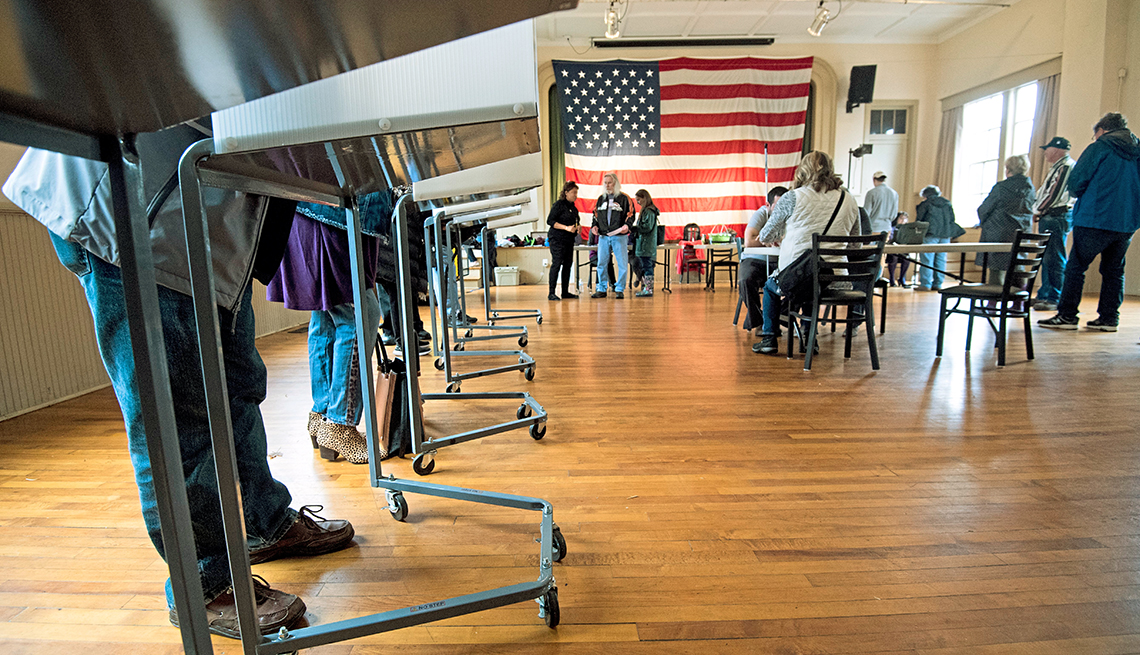
- Select a language for the TTS:
- UK English Female
- UK English Male
- US English Female
- US English Male
- Australian Female
- Australian Male
- Language selected: (auto detect) - EN
Play all audios:
Conventional wisdom says voters will cast their ballots in the all-important midterm elections this November based on their party affiliation or the latest political buzz on the national
scene. But older voters have a message for candidates: Ignore our issues at your peril. We vote in big numbers. And we care about the issues that shape our lives. “We know that people 50 and
older vote more than any other age group,” says Bill Sweeney, AARP senior vice president for government affairs. Sweeney points out that overall turnout tends to be lower in a
nonpresidential year, and that will make the 50-plus vote even more important. Take the last midterm elections, in 2018: Turnout among Americans ages 45 to 59 was 56 percent; among voters 60
and over, the rate was 66 percent. The turnout among voters ages 18 to 29 that year? Just 33 percent. “We also know that voters 50 and older take time to find out where candidates stand on
the issues,” says Sweeney. “They want to make sure that the people they are voting for are really going to represent them.” USE YOUR POWER TO DECIDE THE 2022 ELECTION Americans 50+ can use
their vote to decide the 2022 elections. Commit today to be a Decider and join our fight to make sure candidates keep their promises to preserve Social Security and Medicare. Join the fight
This election, voters across all age groups report being worried about pocketbook items like the price of food and gas. Continuing concerns over COVID-19 and voting rights, as well as local
education issues, also rank high in preliminary surveys. But older Americans have their own issues that are top of mind. They want to know candidates’ views on them and will be evaluating
how much progress incumbent lawmakers in Washington and in their state have made. Here are four that surveys show are top of mind among older voters. PRESCRIPTION DRUGS AT ISSUE: Americans
continue to pay among the highest prices in the world for prescription drugs, and the problem’s not going away: List prices of pharmaceuticals increased by an average of 5.2 percent in 2021
for many of the medications that Medicare spends the most on. Medicare beneficiaries, who have a median annual income of just under $30,000, take an average of four to five prescription
drugs every month and public opinion surveys consistently have found that many beneficiaries skip doses or don’t refill their prescriptions because of the cost. STATUS: In December, the U.S.
House of Representatives passed the Build Back Better Act of 2021, which included prescription drug reforms. The U.S. Senate has not acted on this bill even though lawmakers on both sides
of the aisle say they want to lower the cost of prescription drugs. In individual states, about 90 Rx-related bills were enacted in 2020 and 2021, according to the National Academy for State
Health Policy. AARP’s state offices helped get 53 bills or regulations passed during that time, including measures requiring transparency in drug pricing, allowing lower-cost medications to
be safely imported from Canada, creating state-based drug assistance programs, preventing midyear changes to the lists of drugs that plans cover and capping out-of-pocket costs on insulin.
WHAT OLDER VOTERS WANT: AARP’s Fair Rx Prices Now campaign has called on Congress to pass these measures to help lower prescription drug prices: Allow Medicare to negotiate prices with
drugmakers, impose tax penalties on manufacturers that raise prices higher than the rate of general inflation and put a cap on out-of-pocket costs for those enrolled in Medicare Part D
prescription drug plans. “Millions of Americans are looking to their elected leaders from both parties to put their differences aside and work together to lower drug prices,” said Nancy
LeaMond, AARP executive vice president and chief advocacy and engagement officer. SOCIAL SECURITY AT ISSUE: Roughly 1 in 5 Americans (47 million retired workers, 2.8 million of their
dependents, 5.9 million survivors of deceased workers and 9.5 million people with disabilities and their dependents) receive Social Security benefits. According to the Social Security
trustees, unless Congress steps in to act by 2034 the program’s trust fund will be depleted, meaning Social Security will not have the funds needed to pay full benefits to the retired
workers who paid into the plan for all their working lives. “The next two years are going to be very important for Social Security,” says Sweeney, because lawmakers look ahead for a decade
when making their overall budget plans. STATUS: Although dozens of lawmakers have introduced bills that would do everything from tweaking Social Security to completely overhauling the
program, there is scant agreement on Capitol Hill on how to proceed. Suggested fixes include everything from raising the cap on how much income is subject to the Social Security payroll tax,
to increasing the tax rate, to upping the eligibility age, to modifying benefits. WHAT OLDER VOTERS WANT: Americans want certainty that the plan will be there and well-funded when they
retire. AARP has called on Congress to ensure the long-term solvency of the program and protect the benefits of current beneficiaries and generations of workers to come. MEDICARE AT ISSUE:
Medicare covers more than 64 million older Americans and people with disabilities, and that number is projected to reach 80 million by 2030. Workers and their employers pay into the program
through a payroll tax. Within four years, Medicare’s Part A Hospital Insurance Trust Fund is projected to run short of funds as a result of rising enrollment, increasing health care costs
and advances in medical technologies. Parts B and D will remain fully funded. Medicare continues to have coverage gaps, including coverage for dental, hearing and vision. STATUS: The Build
Back Better Act the House passed included some coverage for hearing aids and other hearing services for people enrolled in original Medicare. Already virtually all Medicare Advantage private
insurance plans provide some dental, vision and hearing benefits. So far Congress has not begun any significant debate on how to shore up the hospital trust fund. WHAT OLDER VOTERS WANT:
“We are going to be committed and keep fighting” to maintain and expand Medicare coverage, Sweeney says. During the COVID-19 pandemic, Medicare expanded its coverage of telehealth, something
older voters want to be made permanent. To protect the program for the future, older voters also want Medicare to crack down on waste, fraud and abuse.




